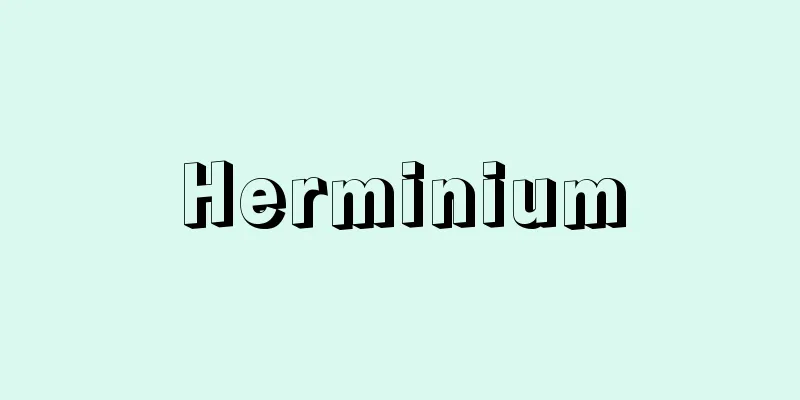Brandy - Brandy (English spelling)

|
The word brandy comes from the Dutch word brandewijn, which means to burn wine. In France, it is called eau-de-vie (water of life). In German, it is called Brantwein, and in Japan, it is translated as fire wine. [Hara Masamichi] Classification and definitionGenerally, it is a distilled fruit wine, but under the definition of Japan's Liquor Tax Act, it is classified into the following three types. (1) Made by fermenting fruit or fruit and water and then distilling it. (2) The finished fruit wine (or fruit wine lees) is distilled. In both (1) and (2), the alcohol content of the distillate must be less than 95%. (3) Spirits, flavorings, etc. added to the above (1) and (2). Under the Liquor Tax Act, brandy is defined as distilled fruit liquor, but the term brandy is generally used only to refer to liquor made from wine. Other fruit liquors, such as those made from apple wine, are called apple brandy, with the name of the ingredient added to it. [Hara Masamichi] historyBrandy is a relatively new alcoholic drink, while wine is a prehistoric drink. It is not clear who first distilled wine, but there are records of doctors and alchemists in Europe distilling wine in the 12th and 13th centuries. The Spanish alchemist Arnaud is particularly famous and is considered to be the father of brandy. However, brandy was not actually made until the 16th and 17th centuries. According to one theory, it began when a Dutch pharmacist happened to pass through the Cognac region of Charente, France, and distilled wine to help farmers who were suffering from an overproduction of wine and solve their storage problems. Later, thanks to the protective policies of Louis XIV and the support of the Napoleon family, brandy from Cognac spread throughout the world, along with the name "Napoleon", which is used to label high-quality brandy. It was first introduced to Japan in 1651 (Keian 4), slightly later than wine, and there are records that it was brought to Edo by the Dutch. [Hara Masamichi] How to make itFor brandy, grapes of the Vitis vinifera variety, which have a less distinctive aroma, are used. Unlike wine, grapes with a high acidity and low sugar content (18-19%) are better. Since sulfurous acid is not used for brandy, grapes with a strong acidity are considered appropriate to prevent the resulting wine from spoiling. The preparation method is the same as for white wine, and the wine is distilled as soon as possible after fermentation by yeast is complete. If wine is left for a long time without distillation, it may spoil because its alcohol content is low (7-8%) and it does not contain sulfurous acid. Distillation is usually done twice using a single distiller (pot still). The first distillation is called the crude distillate, and a distillate with an alcohol content of about 24-30% is obtained. This is then distilled again, and the first and second distillates are appropriately removed, and only the good parts are collected. The alcohol content is 60-70%. This distillate is filled into oak barrels with a capacity of 400-600 liters and stored for a long period of time to mature. The material of the barrel is very important, and usually oak from the Limousin region is used for Cognac, and oak from the Gascon region is used for Armagnac. During storage, the roughness of the new wine disappears, it becomes rounder, the aroma specific to brandy increases, it becomes sweeter, and it turns amber in color. The stored wine is finally blended to adjust the flavor and is made into the product. [Hara Masamichi] kindsThere are many different types of brandy depending on the ingredients and place of origin. (1) Grape brandy: This is the ordinary type of brandy, generally of the best quality. (2) Cognac: Brandy made in the Cognac region in southwestern France. (3) Armagnac This is a brandy produced in the Armagnac region in southwestern France, and only those that meet certain standards can be sold under the name Armagnac. The grape varieties used are mainly Folle Blanche and Saint-Emilion. Unlike Cognac, distillation is usually done only once using a continuous still. Therefore, much of the flavor and aroma of the raw wine is transferred to the distillate, resulting in a brandy with a rich, strong aroma. The alcohol content of the distillate is lower than Cognac, at 55-60%. However, the same distillation method as Cognac is currently permitted. (4) Pomace brandy Distilled from the pomace left over from the production of red wine. It can be made by directly distilling the pomace with steam, by adding water to the pomace to extract the alcohol and other volatile components, and then distilling this, or by adding water to the pomace and then adding sugar, and then distilling the fermented liquid. In French, it is called eau de vie de marl. (5) Lees Brandy: Distilled by adding water to the lees of wine. (6) Raisin brandy: Distilled liquor made from raisins. (7) Apple brandy: Made by distilling fermented apple juice. In England, apple brandy is made by distilling hard cider, while applejack is made by diluting apple juice lees with water, fermenting it, and distilling it. In America, this distinction is not clear. In France, Calvados is the name given to brandy distilled from apple wine made in the Calvados department in Normandy, and Calvados from the village of Douge is particularly famous. (8) Kirschwasser: Made by fermenting and distilling cherries. (9) Plum Brandy Brandy made by fermenting and distilling plums. The average alcohol content is around 40%. Brandy made from plums grown in central Europe (Yugoslavia, Romania, etc.) is called Slibovitz, while brandy made from yellow plums grown in Alsace, France, and Baden, Germany, is called Mirabelle. [Hara Masamichi] How to drinkBrandy is a drink that is enjoyed by appreciating its aroma and savoring the flavor. It is customary to pour a small amount (about 30 milliliters) into a large tulip-shaped brandy glass, warm it by supporting it with one or both hands, slowly swirling it to bring out the aroma, and then sipping while smelling the aroma. It can also be added to coffee. Armagnac, in particular, is popular for its aromatic flavor. It is also used as a cocktail base. Fruit brandy can be drunk neat, but is often used as an ingredient in liqueurs. [Hara Masamichi] "World Alcohol 3" by Munetaka Inoue (1989, Kadokawa Shoten) [Reference] | | | | | | |Source: Shogakukan Encyclopedia Nipponica About Encyclopedia Nipponica Information | Legend |
|
ブランデーの語源はオランダ語のブランデウェインbrandewijnに由来しており、これはワインを焼くという意味である。フランスではオー・ド・ビィeau-de-vie(生命の水)とよんでいる。ドイツ語でブラントバインBranntwein、日本では火酒と訳している。 [原 昌道] 分類・定義一般的には果実酒を蒸留した酒であるが、わが国の酒税法上の定義では次の三つに分類される。 (1)果実または果実と水を原料として発酵させ、ついで蒸留したもの。 (2)できあがった果実酒(果実酒粕(かす)でもよい)を蒸留したもの。(1)、(2)ともに蒸留時に留出物のアルコールは95%未満である必要がある。 (3)前記の(1)、(2)にスピリッツ、香味料などを加えたもの。 なお酒税法上は、ブランデーは果実酒を蒸留したものとなっているが、一般にブランデーという場合はワインを原料としたもののみに使われ、ほかの果実酒、たとえばりんご酒を原料としたものなどは、その上に原料の名称をつけてアップルブランデーなどとよばれる。 [原 昌道] 歴史ブランデーは、ワインが有史以前の酒であるのに対して比較的新しい酒である。だれが最初にワインを蒸留したかは明らかでないが、ヨーロッパで12~13世紀ごろ、医師や錬金術師がワインの蒸留を行ったとの記録がある。とくにスペインの錬金術師のアルノーの名が高く、ブランデーの祖とされている。しかし実際にブランデーがつくられたのは16~17世紀になってからで、一説によると、オランダ人の薬剤師がたまたまフランスのシャラント県のコニャック地方を通りかかった際、ワインが生産過剰になり困っている農民を救うために、ワインを蒸留し、貯蔵の問題を解決したのが始まりといわれている。その後ルイ14世の保護政策、ナポレオン家の援助などによって、コニャック産のブランデーは、高級ブランデーの品質表示に付けられる「ナポレオン」の名とともに全世界に広まった。日本に初めて渡来したのは、ワインよりもやや遅い1651年(慶安4)で、オランダ人によって江戸にもたらされたとの記録がある。 [原 昌道] 作り方ブランデー用には、香りに特徴の少ないビニフェラ種のブドウが使われる。ワイン用と異なり酸が多く、糖分は18~19%と低い原料ブドウのほうがよい。ブランデー用には亜硫酸を使用しないから、生成ワインの変敗がおこらないように酸味の強いブドウが適当とされる。仕込み方法は白ワインと同様で、酵母による発酵終了後、できるだけ早く蒸留する。ワインを蒸留しないで長く放置すると、アルコール度数が7~8%と低く、かつ亜硫酸が含まれていないから、変敗するおそれがある。蒸留は単式蒸留機(ポットスチル)を使い、通常2回行う。1回目は粗留といい、アルコール分24~30%程度の留液を得る。ついでこれをふたたび蒸留し、初留と後留を適当に除いて、良質部のみを集める。アルコール分は60~70%である。この留液を400~600リットルの容量の樫樽(かしたる)に詰め、長期間貯蔵し熟成させる。樽の材質は非常に重要で、通常コニャックにはリムーザン地方のカシ、アルマニャックにはガスコン地方のカシが用いられる。貯蔵中、新酒の荒さは消え、まるくなり、ブランデー特有の香りが増し、甘味もついて、琥珀(こはく)色に変わる。貯蔵酒は最後にブレンドして風味を調整し、製品とする。 [原 昌道] 種類ブランデーは原料別、産地別によっていろいろな種類がある。 (1)ブドウブランデー 普通のブランデーで、一般にもっとも良質である。 (2)コニャック フランス南西部にあるコニャック地方でつくられるブランデー。 (3)アルマニャック フランス南西部、アルマニャック地方に産するブランデーで、一定の規格にあったもののみがアルマニャックという名をつけて売られる。ブドウの品種はフォルブランシュ種、サンテミリオン種がおもに使われる。蒸留はコニャックと違って普通連続式蒸留機を用いて1回だけ行われる。したがって原料ワインの風味と香りが留液に多く移行し、こくのある強い香りのブランデーが得られる。留液のアルコール分はコニャックよりも低く55~60%である。なお、現在はコニャックと同じ蒸留法も許可されている。 (4)粕(かす)ブランデー 赤ワインを製造するときの絞り粕を蒸留したもの。絞り粕を直接蒸気で蒸留するか、絞り粕に水を加えてアルコールをはじめ揮発成分を抽出し、これを蒸留する方法、あるいは絞り粕に水を加え、さらに糖を加えて発酵した液を蒸留する方法などがとられる。フランス語でオー・ド・ビィ・ド・マールとよばれる。 (5)おりブランデー ワインの澱(おり)に加水して蒸留したもの。 (6)干しぶどうブランデー 干しぶどうからつくった酒を蒸留したもの。 (7)アップルブランデー りんご果汁の発酵液を蒸留してつくる。イギリスではハードサイダーを蒸留したものをアップルブランデー、リンゴのジュースを絞った粕に水を加えて薄め、発酵させ、蒸留したブランデーをアップルジャックとして区別している。アメリカではこの区別ははっきりしない。なお、フランスではノルマンディー地方のカルバドス県でつくられたりんご酒を蒸留したブランデーをカルバドスとよび、とくにドージュ村のカルバドスは有名である。 (8)キルシュワッサー サクランボを発酵、蒸留してつくる。 (9)プラムブランデー プラムを発酵、蒸留してつくるブランデー。アルコール分は平均40%前後。ヨーロッパ中部地方(ユーゴスラビア、ルーマニアなど)で産するプラムからつくられるブランデーはスリボービッツ、フランスのアルザス地方、ドイツのバーデン地方でとれる黄色いプラムからつくられるブランデーはミラベルとよばれる。 [原 昌道] 飲み方ブランデーは香りを鑑賞し、味わって飲む酒である。大型のチューリップ型をしたブランデーグラスに、少量(約30ミリリットル)注いで、これを両手または片手で支えて温め、ゆっくり回して香りを引き立て、香りをかぎながら飲むのが普通である。コーヒーの中へ入れて飲む場合もある。とくにアルマニャックなどは芳香がたって好まれる。そのほかカクテルベースにも使われる。フルーツブランデーはストレートでも飲まれるが、リキュールの原料として使われる場合が多い。 [原 昌道] 『井上宗和著『世界の酒3』(1989・角川書店)』 [参照項目] | | | | | | |出典 小学館 日本大百科全書(ニッポニカ)日本大百科全書(ニッポニカ)について 情報 | 凡例 |
<<: Branting - Karl Hjalmar Branting
Recommend
Chemical plating - Kagaku plating
In contrast to electroplating, which is the mainst...
Hepatitis - Hepatitis
…His pen name was Kyobou and his pen name was Eih...
Hārūn al‐Rashid
766‐809 The fifth caliph of the Abbasid dynasty. R...
Spiraea japonica (English spelling)
A small shrub of the Rosaceae family. It is found ...
HTML - High-Tech Millionaire
It is a standard for creating web pages. It is als...
Afro Shirazi Party
… On the other hand, Zanzibar achieved independen...
Crabbe, B. (English spelling) CrabbeB
...The serials of the 1930s and 40s were action-p...
Tide - Shio
The periodic rise and fall of sea levels due to th...
Mitrastemon yamamotoi (English name)
An annual parasitic plant of the Rafflesiaceae fam...
Araham (English spelling)
Dates of birth and death unknown. 7th century. A ...
Kindou
How to play the koto. See the entry for "Koto...
Ring-headed sword
…In recent years, bronze swords have been excavat...
Tedori River
A river that flows through the southern part of th...
Venustiano Carranza
Leader of the Mexican Revolution and President of...
Demon mask
〘Noun〙① Demon's face. ※Shobogenzo (1231-53) Ju...









